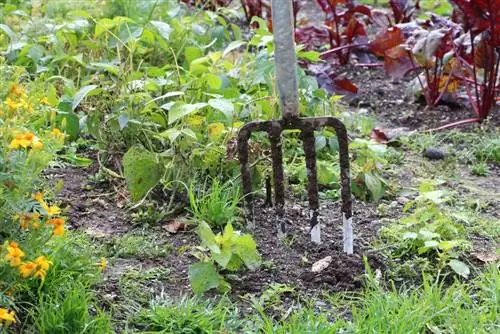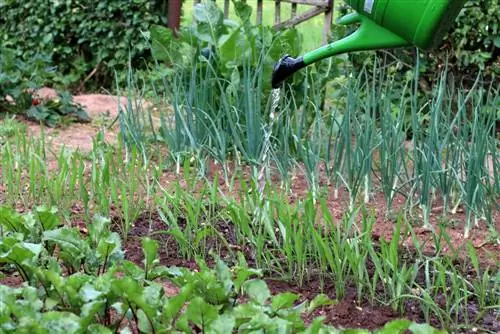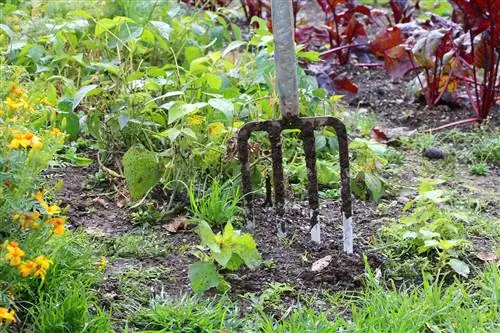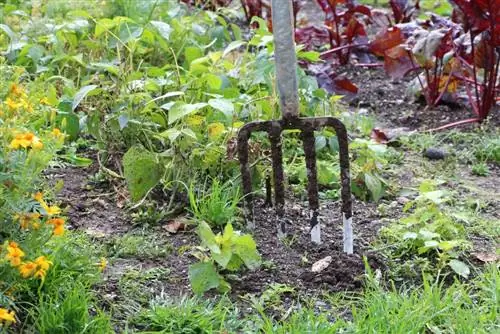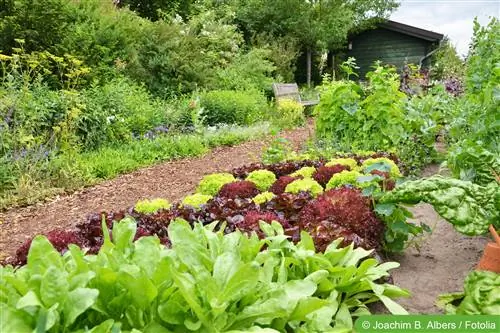- Author admin [email protected].
- Public 2023-12-17 03:39.
- Last modified 2025-06-01 06:48.
Small gardens or allotment gardens are trendy. Many city dwellers really want to create an oasis in the countryside and will spare no effort to achieve this. An allotment garden may not have a lot of space to offer, but it can still inspire with the splendor of the plants. A good idea is to create a mixed garden in which useful plants and ornamental plants grow next to each other. With these tips you can create a beautiful mixed garden on a small scale.
Allotment Garden: Five Elements
A garden arbor belongs in an allotment garden, no matter how small it may be, but its size must not exceed 24 square meters. A shed for garden tools is also helpful. The second element that cannot be missing in an allotment is water. Irrigation water is essential for maintaining the garden. A well is particularly good as a reliable source of water, but a permit is required. A large rain barrel or garden pond serves as a supply of soft water, which is ideal for watering. The bottom of the pond should be covered with a special tarpaulin so that the water does not seep into the bottom. Electricity connection is also a must in an allotment garden. There are numerous lawn mowers, scarifiers and many other garden tools that are powered by electricity in an environmentally friendly manner. The fourth element for successful garden maintenance is a compost heap. Old leaves, hedge cuttings and weeds and of course organic waste of plant origin belong in the compost heap and are a source of nutrient-rich garden soil. The fifth element is intangible but just as important, namely the passion for gardening.
Five elements in the allotment garden:
- Garden gazebo,
- Water,
- Power connection,
- Compost heap and
- Love for Gardening
Site analysis and planning
Before planning can begin, a location analysis of the future garden is required. On the one hand, the soil quality should be determined. Depending on whether the soil is nutrient-rich or nutrient-poor and whether it is sandy or clayey, fertilization should vary in intensity. But the basic rule is that no plants will thrive in the long term without proper, regular fertilization. It is particularly important for the mixed garden, which ideally should produce a decent harvest. The other important location factor is sunlight. The question to be answered here is whether the allotment garden is predominantly in the sun, in partial shade or in the shade. It can be assumed that sunny to partially shaded locations are better suited for most plants than shade. Even the compost heap should preferably not be placed in a shady location, but rather in partial shade. After the location analysis, planning can begin.
Of course, the exact planning of a garden is purely a matter of taste. A mixed garden is not only a source of fresh vegetables and fruit and a feast for the eyes, but should also provide relaxation and comfort. One idea for garden design is to divide the area into four zones. The first of these has a purely practical use, because these are the garden paths. Whether laid with stone slabs or filled with gravel, a garden path should be comfortable. The minimum width is 1.2 m so that the wheelbarrow can get through. The second zone is the lawn. In an allotment garden, the lawn is usually a place to relax, a place for children to run around and a barbecue area all in one. It is therefore advisable to buy seeds for a sports and play lawn. By the way, there are also lawn mixtures for shady areas. The third zone is a small orchard. It should be noted that most fruit trees prefer sunny locations; sour cherries or mirabelle plums, for example, can produce good yields in partial shade. The fourth area in a mixed garden is flowers and vegetable beds. These are meant to be mostly in the sun and require the most attention from the gardener. The most important decision is which plants should be planted in the garden.
Four most important areas in a mixed garden:
- Garden paths,
- Lawn,
- Orchard,
- Flower and vegetable beds.
Mixed culture for mixed gardens - the trend towards naturalness
Naturalness is popular in every respect today. Naturalness in relation to a mixed garden means the trend towards mixed culture: different useful and ornamental plants are planted together in a bed and support each other in growing and fighting pests. The gardener should pay attention to whether the plants tolerate each other. Here are some ideas for beautiful and meaningful bed design. Roses are magnificent flowers that delight many gardeners. Roses thrive best when they grow together with lavender or sage, for example. Lettuce is a good neighbor to beans and peas and gets along well with various types of cabbage. Lettuce can also grow in the same bed with sun-loving strawberries and also dill. Sunflowers look particularly beautiful and feel comfortable in a bed with cucumbers. Zucchini doesn't like to be planted with cucumbers, but they love being next to basil and onions. Rhubarb is very tolerable and can be planted in a bed with bush beans or spinach, for example. A tomato bed can be created with radishes and marigolds, celery and onions.
These are just a few ideas for designing beds with mixed cultures. For optimal soil use, it is not only important to plant the right plant species, but also crop rotation. A four-year model has proven to be successful, in which the green manure is followed by the heavy feeders such as cucumbers or cabbages, first the medium feeders (carrots or lettuce) and lastly the weak feeders (onions, radishes or even beans). Ornamental flowers do not necessarily have to grow in the same bed with vegetables, but can alternatively form a beautiful border for beds with mixed crops. For mixed culture, note:
- Not all types of vegetables and flowers get along without problems,
- Crop rotation enables optimal soil use and productive harvests.
Vegetables and fruit can also be successfully grown in an allotment garden. Rest areas serve to relax and colorful flowerbeds are pleasing to the eye.
What you should know about your own allotment garden soon
Germans are known for loving their gardens. If you don't have a garden behind your house, you often opt for an allotment. The diversity in the design of an allotment garden is unparalleled, because whether it's an allotment garden with a country look with a herb corner, a natural collector's garden with a wildflower meadow, vegetable beds for your own consumption or with noble lawns and strict pebble paths - you can find it all in the German allotment garden colonies:
- The self-sufficient garden is very popular and uses and recycles everything that grows here. Fruit is mainly used to make jam or to make delicious cakes. Vegetables such as tomatoes, potatoes and salads are also regularly served and cannot be fresher.
- There are also some allotment gardeners who plant historic vegetables such as flat peas, yellow beets or black carrots. You can let everything grow wildly and enjoy the pure nature or lay out the vegetable beds perfectly straight and maintain them meticulously.
- Other allotments are completely overgrown and you can see shrub roses, lilacs and delphiniums. There are also narrow and winding paths, many perennials, fruit trees and roses. However, such gardens are very rare to find, because in most allotment garden colonies everything goes strictly according to the rules. Woe betide you, a plant grows the way it wants and is not trimmed.
- However, all allotment gardeners agree on one thing: the allotment garden is a true paradise for hobby gardeners, because here you can let off steam and experience nature. It's always nicest when there's just grass and maybe a few trees at first. Because when it comes to gardening, the path is always the goal and so it's incredibly fun to create curbs and paths, perhaps a small pond and round beds.
- Walls made of natural stone always appear harmonious and so you can create your own personal paradise and watch the flowers and plants wake up. It is not uncommon for someone without the famous green thumb to become a true gardening expert through their allotment, because nature fascinates everyone when you take a closer look at it.
Tip:
You can get a first impression of life in an allotment garden colony at an open day, because at least once a year many allotment gardeners open their gates and proudly show off their little paradise.

